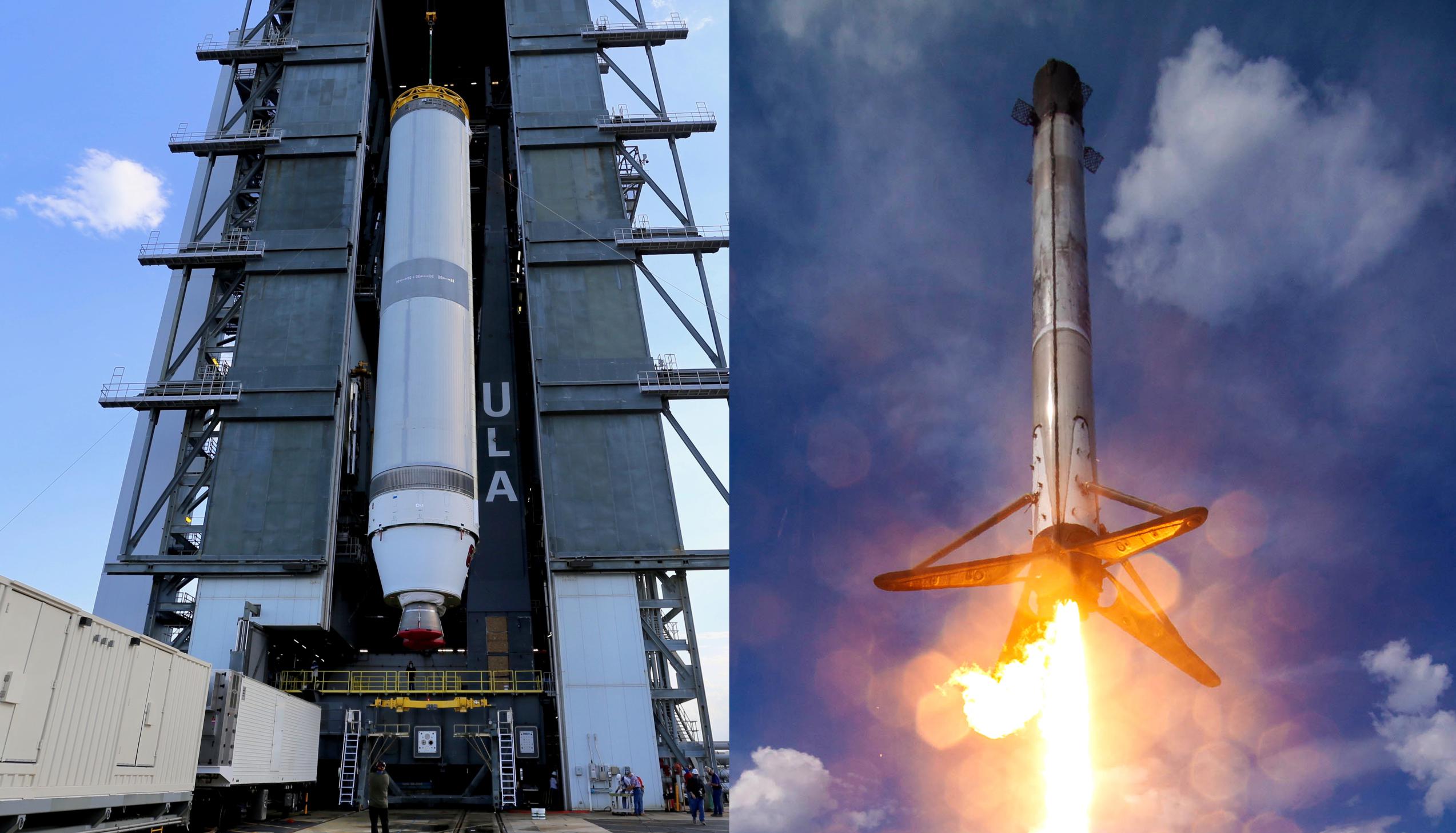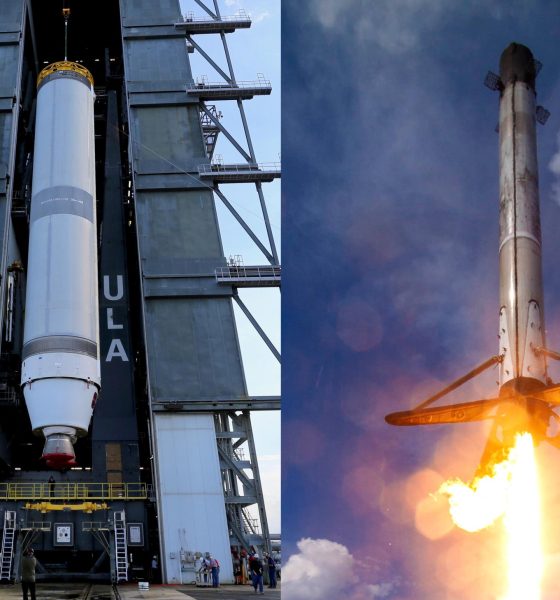

News
SpaceX, ULA awarded eight more US military launch contracts
The US military has awarded providers SpaceX and the United Launch Alliance (ULA) another eight launch contracts worth a total of $846 million that the companies will be tasked with completing over the next two or so years.
The US Space Systems Command (SSC) announced the decision on May 26th, providing some basic information about which missions were going to which provider. Per a highly unusual National Security Space Launch (NSSL) Phase 2 competition that ULA and SpaceX ultimately won in 2020, all major US military launches scheduled between 2020 and 2024 (at minimum) are to be split 60:40 between the companies, and this latest set of missions – more ‘funded’ than ‘awarded’ – are no different. Curiously, they also appear to indicate less of a cost cap than usual between SpaceX and its lone US competitor.
SpaceNews author Sandra Erwin has done an excellent job collating extra information about the eight launches rewarded. The latest batch continue a bizarre trend of the US military awarding complex, high-performance missions to ULA’s Vulcan Centaur, a rocket that has never flown and is unlikely to debut before 2023. Meanwhile, SpaceX’s Falcon 9 rocket, which is the most flown and most statistically reliable rocket currently in operation, continues to be used primarily for much simpler launches to lower orbits.
With this latest batch, ULA’s Vulcan Centaur rocket was assigned GPS III SV07 (headed to a medium Earth orbit); WGS-11, a geostationary military communications satellite; and USSF-16, USSF-23, and USSF-43, which are classified and unidentified. SpaceX’s Falcon 9 rocket was assigned USSF-124 (headed to low Earth orbit), USSF-62 (a military weather satellite headed to a polar orbit), and SDA Tranche 1 (a set of small communications satellites, some built by SpaceX, headed to a low polar orbit).
According to SpaceNews, ULA was awarded $566 million (~$113 million per launch) and SpaceX was awarded $280 million for its three contracts, meaning that SpaceX is charging an unusually high ~$93 million per Falcon 9 launch. Each of SpaceX’s three missions will almost certainly allow for Falcon 9 booster recovery, making the high cost even more odd.
Through its adherence to a bizarre 60:40 contract split that can only be described as an effort to ensure that ULA – possibly already predetermined to win before the competition began – would receive a lion’s share of contracts, has firmly hitched several near-term carts to a rocket that still hasn’t launched 22 months after its victory. Including a demonstration mission carrying a Moon lander and one or two NASA Cargo Resupply Services (CRS) missions carrying Sierra Nevada Corporation’s Dream Chaser space plane and cargo vehicle, Vulcan Centaur now has at least 11 launches – 10 for the US government – planned in 2023 and 2024.
Blue Origin, a company that has yet to deliver a single flightworthy BE-4 rocket engine to ULA, would need to deliver at least 22 engines over the next two or so years to avoid delaying Vulcan’s manifest. ULA’s existing rockets, Atlas V and Delta IV, each completed four launches in their first two years of service. SpaceX’s Falcon 9 was no different, launching four times in its first 2.5 years of operation. Only time will tell if Vulcan can more than double the early records of its closest rocket siblings.

Elon Musk
Elon Musk and Tesla AI Director share insights after empty driver seat Robotaxi rides
The executives’ unoccupied tests hint at the rapid progress of Tesla’s unsupervised Robotaxi efforts.

Tesla CEO Elon Musk and AI Director Ashok Elluswamy celebrated Christmas Eve by sharing personal experiences with Robotaxi vehicles that had no safety monitor or occupant in the driver’s seat. Musk described the system’s “perfect driving” around Austin, while Elluswamy posted video from the back seat, calling it “an amazing experience.”
The executives’ unoccupied tests hint at the rapid progress of Tesla’s unsupervised Robotaxi efforts.
Elon and Ashok’s firsthand Robotaxi insights
Prior to Musk and the Tesla AI Director’s posts, sightings of unmanned Teslas navigating public roads were widely shared on social media. One such vehicle was spotted in Austin, Texas, which Elon Musk acknowleged by stating that “Testing is underway with no occupants in the car.”
Based on his Christmas Eve post, Musk seemed to have tested an unmanned Tesla himself. “A Tesla with no safety monitor in the car and me sitting in the passenger seat took me all around Austin on Sunday with perfect driving,” Musk wrote in his post.
Elluswamy responded with a 2-minute video showing himself in the rear of an unmanned Tesla. The video featured the vehicle’s empty front seats, as well as its smooth handling through real-world traffic. He captioned his video with the words, “It’s an amazing experience!”
Towards Unsupervised operations
During an xAI Hackathon earlier this month, Elon Musk mentioned that Tesla owed be removing Safety Monitors from its Robotaxis in Austin in just three weeks. “Unsupervised is pretty much solved at this point. So there will be Tesla Robotaxis operating in Austin with no one in them. Not even anyone in the passenger seat in about three weeks,” he said. Musk echoed similar estimates at the 2025 Annual Shareholder Meeting and the Q3 2025 earnings call.
Considering the insights that were posted Musk and Elluswamy, it does appear that Tesla is working hard towards operating its Robotaxis with no safety monitors. This is quite impressive considering that the service was launched just earlier this year.
Elon Musk
Starlink passes 9 million active customers just weeks after hitting 8 million
The milestone highlights the accelerating growth of Starlink, which has now been adding over 20,000 new users per day.

SpaceX’s Starlink satellite internet service has continued its rapid global expansion, surpassing 9 million active customers just weeks after crossing the 8 million mark.
The milestone highlights the accelerating growth of Starlink, which has now been adding over 20,000 new users per day.
9 million customers
In a post on X, SpaceX stated that Starlink now serves over 9 million active users across 155 countries, territories, and markets. The company reached 8 million customers in early November, meaning it added roughly 1 million subscribers in under seven weeks, or about 21,275 new users on average per day.
“Starlink is connecting more than 9M active customers with high-speed internet across 155 countries, territories, and many other markets,” Starlink wrote in a post on its official X account. SpaceX President Gwynne Shotwell also celebrated the milestone on X. “A huge thank you to all of our customers and congrats to the Starlink team for such an incredible product,” she wrote.
That growth rate reflects both rising demand for broadband in underserved regions and Starlink’s expanding satellite constellation, which now includes more than 9,000 low-Earth-orbit satellites designed to deliver high-speed, low-latency internet worldwide.
Starlink’s momentum
Starlink’s momentum has been building up. SpaceX reported 4.6 million Starlink customers in December 2024, followed by 7 million by August 2025, and 8 million customers in November. Independent data also suggests Starlink usage is rising sharply, with Cloudflare reporting that global web traffic from Starlink users more than doubled in 2025, as noted in an Insider report.
Starlink’s momentum is increasingly tied to SpaceX’s broader financial outlook. Elon Musk has said the satellite network is “by far” the company’s largest revenue driver, and reports suggest SpaceX may be positioning itself for an initial public offering as soon as next year, with valuations estimated as high as $1.5 trillion. Musk has also suggested in the past that Starlink could have its own IPO in the future.
News
NVIDIA Director of Robotics: Tesla FSD v14 is the first AI to pass the “Physical Turing Test”
After testing FSD v14, Fan stated that his experience with FSD felt magical at first, but it soon started to feel like a routine.

NVIDIA Director of Robotics Jim Fan has praised Tesla’s Full Self-Driving (Supervised) v14 as the first AI to pass what he described as a “Physical Turing Test.”
After testing FSD v14, Fan stated that his experience with FSD felt magical at first, but it soon started to feel like a routine. And just like smartphones today, removing it now would “actively hurt.”
Jim Fan’s hands-on FSD v14 impressions
Fan, a leading researcher in embodied AI who is currently solving Physical AI at NVIDIA and spearheading the company’s Project GR00T initiative, noted that he actually was late to the Tesla game. He was, however, one of the first to try out FSD v14.
“I was very late to own a Tesla but among the earliest to try out FSD v14. It’s perhaps the first time I experience an AI that passes the Physical Turing Test: after a long day at work, you press a button, lay back, and couldn’t tell if a neural net or a human drove you home,” Fan wrote in a post on X.
Fan added: “Despite knowing exactly how robot learning works, I still find it magical watching the steering wheel turn by itself. First it feels surreal, next it becomes routine. Then, like the smartphone, taking it away actively hurts. This is how humanity gets rewired and glued to god-like technologies.”
The Physical Turing Test
The original Turing Test was conceived by Alan Turing in 1950, and it was aimed at determining if a machine could exhibit behavior that is equivalent to or indistinguishable from a human. By focusing on text-based conversations, the original Turing Test set a high bar for natural language processing and machine learning.
This test has been passed by today’s large language models. However, the capability to converse in a humanlike manner is a completely different challenge from performing real-world problem-solving or physical interactions. Thus, Fan introduced the Physical Turing Test, which challenges AI systems to demonstrate intelligence through physical actions.
Based on Fan’s comments, Tesla has demonstrated these intelligent physical actions with FSD v14. Elon Musk agreed with the NVIDIA executive, stating in a post on X that with FSD v14, “you can sense the sentience maturing.” Musk also praised Tesla AI, calling it the best “real-world AI” today.








